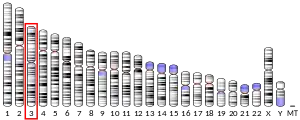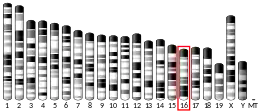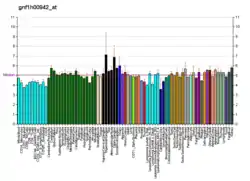GPR128
G protein-coupled receptor 128 is a protein encoded by the ADGRG7 gene.[5][6][7] GPR128 is a member of the adhesion GPCR family.[8][9] Adhesion GPCRs are characterized by an extended extracellular region often possessing N-terminal protein modules that is linked to a TM7 region via a domain known as the GPCR-Autoproteolysis INducing (GAIN) domain.[10]
GPR128 is specifically expressed in human liver as well as in mouse bone marrow and intestinal tissues.[11]
Function
Ni et al. showed that Gpr128 deletion in mice causes reduced body weight and induced intestinal contraction frequency.[12]
Clinical significance
A 111-kb copy number gain with breakpoints within the TRK-fused gene (a target of translocations in lymphoma and thyroid tumors) and GPR128 has been identified in the genome of patients with atypical myeloproliferative neoplasms.[13] Notably, the fused gene was also detected in few healthy individuals.
References
- GRCh38: Ensembl release 89: ENSG00000144820 - Ensembl, May 2017
- GRCm38: Ensembl release 89: ENSMUSG00000022755 - Ensembl, May 2017
- "Human PubMed Reference:". National Center for Biotechnology Information, U.S. National Library of Medicine.
- "Mouse PubMed Reference:". National Center for Biotechnology Information, U.S. National Library of Medicine.
- "Entrez Gene: GPR128 G protein-coupled receptor 128".
- Fredriksson R, Lagerström MC, Höglund PJ, Schiöth HB (November 2002). "Novel human G protein-coupled receptors with long N-terminals containing GPS domains and Ser/Thr-rich regions". FEBS Letters. 531 (3): 407–14. doi:10.1016/S0014-5793(02)03574-3. PMID 12435584. S2CID 7449692.
- Hamann, J; Aust, G; Araç, D; Engel, FB; Formstone, C; Fredriksson, R; Hall, RA; Harty, BL; Kirchhoff, C; Knapp, B; Krishnan, A; Liebscher, I; Lin, HH; Martinelli, DC; Monk, KR; Peeters, MC; Piao, X; Prömel, S; Schöneberg, T; Schwartz, TW; Singer, K; Stacey, M; Ushkaryov, YA; Vallon, M; Wolfrum, U; Wright, MW; Xu, L; Langenhan, T; Schiöth, HB (April 2015). "International Union of Basic and Clinical Pharmacology. XCIV. Adhesion G protein-coupled receptors". Pharmacological Reviews. 67 (2): 338–67. doi:10.1124/pr.114.009647. PMC 4394687. PMID 25713288.
- Stacey M, Yona S (2011). Adhesion-GPCRs: Structure to Function (Advances in Experimental Medicine and Biology). Berlin: Springer. ISBN 978-1-4419-7912-4.
- Langenhan, T; Aust, G; Hamann, J (21 May 2013). "Sticky signaling--adhesion class G protein-coupled receptors take the stage". Science Signaling. 6 (276): re3. doi:10.1126/scisignal.2003825. PMID 23695165. S2CID 6958640.
- Araç D, Boucard AA, Bolliger MF, Nguyen J, Soltis SM, Südhof TC, Brunger AT (March 2012). "A novel evolutionarily conserved domain of cell-adhesion GPCRs mediates autoproteolysis". The EMBO Journal. 31 (6): 1364–78. doi:10.1038/emboj.2012.26. PMC 3321182. PMID 22333914.
- Hamann J, Aust G, Araç D, Engel FB, Formstone C, Fredriksson R, Hall RA, Harty BL, Kirchhoff C, Knapp B, Krishnan A, Liebscher I, Lin HH, Martinelli DC, Monk KR, Peeters MC, Piao X, Prömel S, Schöneberg T, Schwartz TW, Singer K, Stacey M, Ushkaryov YA, Vallon M, Wolfrum U, Wright MW, Xu L, Langenhan T, Schiöth HB (April 2015). "International Union of Basic and Clinical Pharmacology. XCIV. Adhesion G protein-coupled receptors". Pharmacological Reviews. 67 (2): 338–67. doi:10.1124/pr.114.009647. PMC 4394687. PMID 25713288.
- Ni YY, Chen Y, Lu SY, Sun BY, Wang F, Wu XL, Dang SY, Zhang GH, Zhang HX, Kuang Y, Fei J, Gu MM, Rong WF, Wang ZG (January 2014). "Deletion of Gpr128 results in weight loss and increased intestinal contraction frequency". World Journal of Gastroenterology. 20 (2): 498–508. doi:10.3748/wjg.v20.i2.498. PMC 3923024. PMID 24574718.
- Chase A, Ernst T, Fiebig A, Collins A, Grand F, Erben P, Reiter A, Schreiber S, Cross NC (January 2010). "TFG, a target of chromosome translocations in lymphoma and soft tissue tumors, fuses to GPR128 in healthy individuals". Haematologica. 95 (1): 20–6. doi:10.3324/haematol.2009.011536. PMC 2805730. PMID 19797732.




